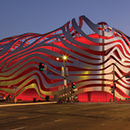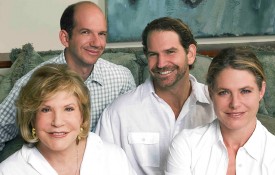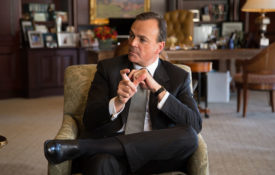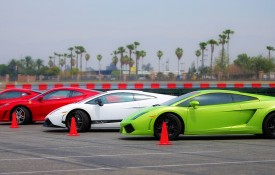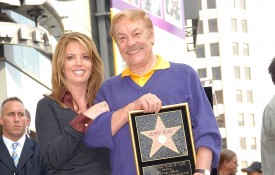Hidden in a former parking garage built in 1926 in one of LA’s toniest neighborhoods is a rare and eclectic collection of some of the finest and most sought after motor vehicles in the world. Encased in a brick and steel vault of a facility, the stark and minimalist architecture showcases the exquisite designs of these rare beauties.
This world-class collection has been assembled over the past 45 years by one of the region’s most iconic car guys, Bruce Meyer. Indeed, Meyer’s considerable reputation is nearly overshadowed by his warm and gregarious personality; he’s a true steward of the car collector world. If you follow that world, from historic racing, rallies, concours, auctions, to special events, your paths will eventually cross. When they do, Meyer has the unique ability to make you feel as if you are the only person in the room.
Meyer started his business career as a real estate investor in Beverly Hills, building an impressive portfolio of prime commercial properties in this most famous ZIP code. In addition, Meyer and his family own the luxury retail emporium Gearys Beverly Hills. This upscale enclave offers glamorous products such as Rolex, Baccarat, Hermes, Lalique, and Faber-Castell pens.

Porsche 935 #41 placed first at Le Mans in 1979, with Kremer Racing. (Photo: Neil G. Philips)
In addition, Meyer was also the founding chairman of the Petersen Automotive Museum and founder of the museum’s support group the Checkered Flag 200. CSQ recently had the rare opportunity to step inside this amazing collection and spent some time with Meyer discussing two of his great passions, his personal collection and the enduring legacy of the Petersen Museum.
CSQ What was your first collector car? What was it about that car that attracted you?
Bruce Meyer It was a 300 SL Gullwing I bought in 1964 for $4,000 after graduating from U.C. Berkeley. It is one of the most timeless and iconic designs of all time, considered one of the first ‘super cars’ and appreciated by people all around the world – not only for its beauty, but as a global car for appreciation and investment.
CSQ You own some of the finest racecars ever produced, rare American muscle cars and classics, hotrods, motorcycles, and even a hydroplane. What inspired you to start collecting such an eclectic mix of vehicles?
BM I was born with the mutant car gene and have collected what appeals to me. I like cars that have completed extraordinary acts, or have been owned by famous people. Each and every vehicle has a great story, and their designs are also very attractive to me.
CSQ If you could only have one car from your collection, what would it be? And, if you could take only one vehicle to participate in any event in the world, what would it be?
BM The Cobra, because it makes great noise, did well on the race track and is an American story. I am a patriot and this car was made in America, by Americans, and has a tremendous racing heritage. Next would be the Hot Rod. It’s pure Americana. It’s like baseball, apple pie, and jazz. Part two of your question, I would take the Cobra. It has been around the world from Budapest to Prague, France, and raced at Lemans. It is also the very first Cobra built, serial number 001.

2/ Meyer’s prized possession, a Carroll Shelby Cobra, signed by Shelby himself. (Photo: Neil G. Philips)
CSQ What was the worst decision you made related to an automobile and why?
BM In 1970 I paid $10,000 for a car, and shortly thereafter a friend wanted me to trade it for a Ferrari GTO he owned, but I declined because it was a stinky old racecar. Today that car is considered one of the most valuable cars in the world, valued between $50 and $60 million. I still own the other car today.
CSQ Please share with our readers your motto and how that applies to your life.
BM I sign on all of my letters ‘Never Lift.’ There is an expression in racing to never take your foot off the gas. That’s how I live my life!
I like cars that have completed extraordinary acts, or have been owned by famous people. Each and every vehicle has a great story, and their designs are also very attractive to me.
CSQ You were the founding chairman of the Petersen Museum, and you’ve continued to be involved [currently as vice chairman] throughout its history. How has the museum changed since its inception?
BM This was originally an offshoot of the Natural History Museum. I was on the board of the Museum when Robert E. Petersen had proposed moving his automotive museum that was located in Hollywood into the facility with the Natural History Museum. He felt it was a great location being across the street from LACMA. I was excited about the idea and became the first chairman of the board for the Petersen. The partnership between the two museums was a mismatch, so eventually they dedicated the facility exclusively to the Petersen. I founded the Checkered Flag 200 as an enthusiast group to raise money to help fund this nonprofit. Today the CF200 has 505 members paying $1,500 a year. Not only are they supporters but also tremendous enthusiasts.
CSQ The new architectural look is very bold and modern. How was this design chosen and how does it fit with the spirit of the museum?
BM The old Petersen was in an old remodeled department store. For the first 22 years, people drove by and had no idea what was inside. It needed to be updated to draw in visitors. We wanted an exterior that would stop traffic. The new design will definitely stop traffic with its red and chrome features. It looks like speed and motion. The interior is also state-of-the-art with partnerships with Pixar, Xbox, and major automotive companies specializing in the technology arena. There will be lots of video and LEDs throughout the museum.

In the foreground on the left, a 1955 Mercedes Benz 300sl (Photo: Bruce Meyer)
CSQ What parallels do you think the Petersen has with other fine art museums in Los Angeles?
BM There are great partnerships with the other museums including LACMA, The Motion Picture Museum, the La Brea Tar Pits, and The Page Museum. Between all of these museums, there should be something there to ignite you.
CSQ What percentage of the vehicles displayed there does the museum own compared with those on loan from other private collections?
BM The museum has a core collection of top-notch cars. Roughly half of the vehicles on display are owned by the museum and the others will be on loan from major collectors, including exhibitions from the Arturo Keller, Peter Mullin, The Nethercutt [Foundation], Jon Shirley, and of course some of my own vehicles.
CSQ How frequently does the museum change displays?
BM Every 6 to 9 months.
CSQ One of the critical elements to growing the membership with the museum and continuing to develop strong interest in LA’s car culture is making the hobby appealing to the younger generations. How do you see the Petersen being relevant in this area?
BM This is the essence of why we did this. We designed this for the next generation. We’ll have hot rods, muscle cars, super cars, elegant cars, and cars that appeal and are dedicated to kids with the new Pixar display. We also have Xbox stations for people to pick the car they want and drive it.






































